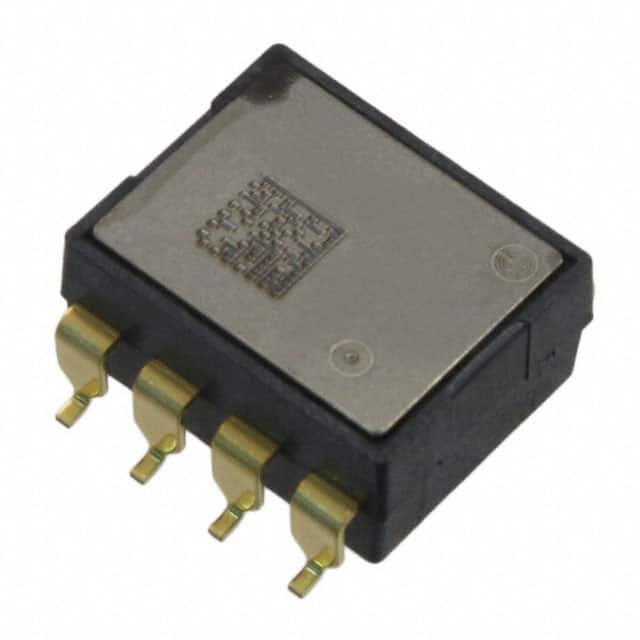SCA610-C13H1A
Product Category: Accelerometer
Basic Information Overview: - Category: Sensor - Use: Measures acceleration in various applications - Characteristics: High sensitivity, low power consumption, compact size - Package: Surface-mount package - Essence: Provides accurate and reliable acceleration data - Packaging/Quantity: Typically sold in reels of 250 or 500 units
Specifications: - Sensing Range: ±2g, ±6g, ±10g, ±15g - Output Type: Analog voltage - Operating Voltage: 2.4V to 3.6V - Operating Temperature Range: -40°C to +85°C - Dimensions: 3mm x 3mm x 1mm
Detailed Pin Configuration: - Pin 1: VDD (Power supply) - Pin 2: GND (Ground) - Pin 3: NC (No connection) - Pin 4: Output
Functional Features: - High sensitivity for accurate measurements - Low power consumption for extended battery life - Small form factor for easy integration into various devices
Advantages: - Accurate and reliable measurement of acceleration - Low power consumption extends battery life - Compact size allows for versatile integration
Disadvantages: - Limited sensing range compared to some other models - Analog output may require additional processing for digital systems
Working Principles: The SCA610-C13H1A operates based on the principle of capacitive sensing. When subjected to acceleration, a mass within the sensor moves, causing a change in capacitance. This change is then converted into an analog voltage signal proportional to the applied acceleration.
Detailed Application Field Plans: - Automotive: Vehicle stability control, rollover detection - Consumer Electronics: Motion-based gaming, device orientation detection - Industrial: Condition monitoring, vibration analysis
Detailed and Complete Alternative Models: 1. SCA100T-D02 - Sensing Range: ±2g, ±6g, ±10g, ±15g - Output Type: Analog voltage - Operating Voltage: 2.4V to 5.25V - Dimensions: 7.6mm x 7.6mm x 3.3mm 2. ADXL335 - Sensing Range: ±3g - Output Type: Analog voltage - Operating Voltage: 1.8V to 3.6V - Dimensions: 4mm x 4mm x 1.45mm
This completes the entry for the SCA610-C13H1A accelerometer, covering its basic information, specifications, pin configuration, functional features, advantages and disadvantages, working principles, application field plans, and alternative models.
10個與SCA610-C13H1A在技術方案中應用相關的常見問題與解答
What is the SCA610-C13H1A accelerometer used for?
- The SCA610-C13H1A accelerometer is commonly used for measuring acceleration in various technical solutions, such as motion detection, vibration monitoring, and tilt sensing.
What is the operating voltage range of the SCA610-C13H1A?
- The operating voltage range of the SCA610-C13H1A is typically between 2.7V and 5.25V.
How does the SCA610-C13H1A communicate with microcontrollers or other devices?
- The SCA610-C13H1A communicates using an analog voltage output, which can be read by analog-to-digital converters (ADCs) in microcontrollers or other devices.
What is the measurement range of the SCA610-C13H1A?
- The SCA610-C13H1A has a measurement range of ±2g, meaning it can measure accelerations up to 2 times the acceleration due to gravity in any direction.
Can the SCA610-C13H1A be used for impact detection?
- Yes, the SCA610-C13H1A can be used for impact detection by measuring sudden changes in acceleration that indicate impacts or collisions.
Is the SCA610-C13H1A suitable for battery-powered applications?
- Yes, the SCA610-C13H1A's low power consumption makes it suitable for battery-powered applications, extending its usability in portable devices.
What are the typical output characteristics of the SCA610-C13H1A?
- The SCA610-C13H1A provides a ratiometric analog voltage output that varies linearly with acceleration.
Can the SCA610-C13H1A be used for tilt sensing applications?
- Yes, the SCA610-C13H1A can be used for tilt sensing applications, providing accurate measurements of tilt angles.
Does the SCA610-C13H1A require external signal conditioning circuitry?
- No, the SCA610-C13H1A includes internal signal conditioning circuitry, simplifying its integration into technical solutions.
Are there any environmental considerations when using the SCA610-C13H1A?
- The SCA610-C13H1A is sensitive to temperature and should be operated within its specified temperature range for optimal performance. Additionally, it may be affected by electromagnetic interference in certain environments.


